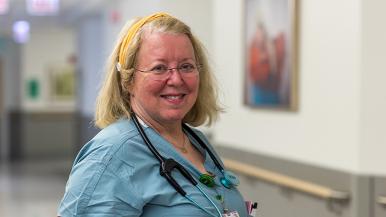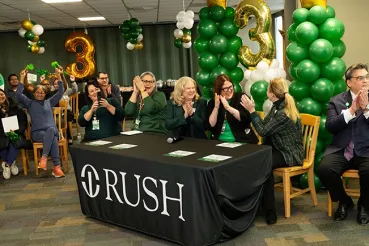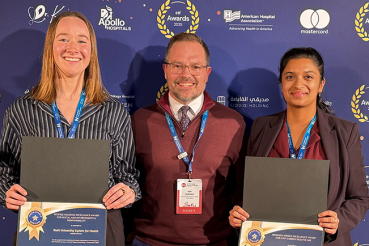Geri Narsete-Prevo, MSN, RN-HROB, CEFM, has made it her life's work to improve the treatment and outcomes for women who hemorrhage during childbirth. Her commitment and excellence have earned her worldwide recognition as the 2022 Magnet Nurse of the Year in the Transformational Leadership category. She received the award from the American Nurses Credentialing Center during the annual Magnet conference in October.
She was chosen among an elite group of nurses worldwide who were nominated for the award, all of them from organizations that the ANCC has given Magnet designation, the highest honor in nursing. (All three RUSH hospitals have received Magnet designation.)
Narsete-Prevo is a senior nurse in labor and delivery at RUSH, where she's worked for her entire 41-year career since graduating from RUSH University College of Nursing. Since 2008, a major part of that work has been her role as chair of the unit's Post-Partum Hemorrhage Committee, leading training of the unit's nurses, and doctors, in the fast-paced, complex care needed to save a hemorrhaging patient.
Hemorrhage — that is, excessive bleeding — is the leading cause of death during childbirth and a major contributor to pregnancy-related deaths, which totaled more than 860 in the United States in 2020 alone. These deaths disproportionately occur in women of color.
Narsete-Prevo's impact has been profound: No deaths from obstetric hemorrhage have occurred in the labor and delivery unit since 2014, and the number of patients who needed to be transferred to one of the medical center's intensive care units after hemorrhaging has decreased dramatically in the past several years.
“Because of Geri's passion to educate our teams on how to manage blood loss during childbirth, we have made a tremendous impact on patient safety," says Melissa Browning, DNP, APRN, CCNS, LSSGB, director of Professional Nursing Practice and the Magnet Program at the medical center.
An example of RUSH nursing excellence
“Geri's award reflects the excellence of RUSH nurses overall. They are smart, skillful and dedicated to our patients, and RUSH ensures their success by letting their voices be heard and supporting them in furthering their education and training so they can achieve their highest potential," says Angelique Richard, PhD, RN, CENP, chief nursing officer and senior vice president of hospital operations for RUSH.
“The award also is a well-deserved recognition of the kind of leadership she and so many other RUSH nurses demonstrate every day. It highlights how RUSH empowers nurses to advance our practice with new ideas and techniques in order to achieve measurably better outcomes for our patients.
“In all these aspects, Geri has exemplified the Magnet model of nursing, so it's only fitting she was named a Magnet Nurse of the Year. I congratulate her and thank her for all she's done for our patients, for our care team and for the advancement of the nursing profession."
“I felt appreciated. This project has been 14 years in the making, and it was nice to have the work recognized," Narsete-Prevo says, while quickly crediting her labor and delivery colleagues Marianne Corrieri-Alaniz, RN, and Tiajuana Tubbs, RN, both also senior nurses, for their work on the committee.
Narsete-Prevo volunteered to chair the committee after the Illinois Department of Public Health required that all hospitals in Illinois providing obstetric care participate in the state's Obstetric Hemorrhage Education Project, which was created to address the “astounding rate" of maternal hemorrhages.
“Compared to other countries, the United States has one of the highest rates of maternal morbidity and mortality" (complications and deaths), observes Denise Banton, MS, RN, unit director of the medical center's antepartum, labor and delivery and postpartum units. “A number of causes contribute to this maternal morbidity and mortality, and one of them is hemorrhage, which requires a concerted effort and prompt recognition and treatment.
“It was important that we find a champion for this project. Geri has always had a passion and love for our more complicated and high-risk patients, and we thought she would be a great fit for it."
Swim lanes and patient simulators
Indeed, Narsete-Prevo welcomed the challenge, which also let her fulfill the expectation that senior nurses at the medical center undertake a project to improve patient care. “The environment we're in at RUSH empowers us to have a voice and implement projects that have a profound impact on our patients," Banton says.
The committee identified “swim lanes" — clearly defined and differentiated roles for nurses to perform during a hemorrhage event — to enhance teamwork; implemented techniques to ensure effective communication; and developed a process to quantify blood loss. Narsete-Prevo created an obstetric massive blood loss protocol in collaboration with the medical center's directors of the blood bank and obstetric anesthesia. She also developed and led drills with nursing staff and physicians using mannequins, including patient simulators from RUSH University's simulation lab.
“Geri has made a difference on the patients, and she's made a difference on the staff, because they have the skills to take care of the patients," Banton says.
This kind of leadership and teaching has been a hallmark of her long career. Narsete-Prevo has been a preceptor for more than 50 new nurses and 20 nursing students, and a basic life support instructor ever since she was teaching Boy Scouts and Girl Scouts while in high school.
A focus on high-risk patients
Her leadership role overlaps with her clinical responsibilities, and draws on her more than four decades of experience providing care in labor and delivery, where 2,600 babies were born in the last year.
“It's very challenging. There's a lot of emergencies. You have to be prepared for everything and anything," she says. “You have to like action. It's very fast-paced. You have to think and learn on your feet, and from each other."
During the time Narsete-Prevo has been a labor and delivery nurse, the number of high-risk pregnancies has increased. “Women are choosing to have babies later, and it has changed obstetrics from decades ago," Banton says, noting the increasing prevalence of conditions such as hypertension and cardiomyopathy, a disease of the heart muscle that impairs its ability to pump blood.
“As time goes on, there's always things that come up in obstetrics that require addressing and intense management of care. Geri's always gravitated to those kinds of patients. She can take care of any patient, a normal, healthy patient, but she is inquisitive and strong in her knowledge and has a love of working for patients who require intensive care."
More than 40 years of sacred events
Labor and delivery was the first unit in her clinical rotations when Narsete-Prevo was a student in the RUSH University College of Nursing, and she fell in love with it then. “Labor and delivery has a little bit of everything," she says. “It has surgery, medicine, emergency medicine, pediatrics and psych.
“You work with a mom and dad getting their child born. It's a sacred event, it's a critical time in people's lives, especially when they hemorrhage — you have to reassure the family while saving the mother's life."
She's helped save a patient who lost 11 liters of blood — more than twice the five liters in the human body — and needed 125 units of transfused blood to survive; provided care for pregnant patients hospitalized with COVID-19; and planned the pre- and post-surgical care for a morbidly obese patient who delivered by cesarean section.
“With that particular patient, we needed lift equipment and a special bed and wheelchair," Narsete-Prevo says. “We had 34 people in the operating room.
“When we have patients who are out of the ordinary, we create care plans and have to be prepared to meet their needs. Labor and delivery, anesthesia, the medical intensive care unit, neonatal intensive care unit and mother baby unit, we all work together as a team to assure patient safety and quality of care."
Empowered to improve care
Narsete-Prevo wanted to be a nurse for as long as she can remember. After beginning her undergraduate studies at the University of Illinois Urbana-Champaign, she chose RUSH for her clinical rotations (which weren't available at U of I) because “it had a great reputation."
She received her degree from Luther Christman, PhD, EdM, the first dean of the College of Nursing and vice president for nursing affairs at what then was known as Rush-Presbyterian-St. Luke's Medical Center. As he gave Narsete-Prevo her diploma, Christman told her to continue on to graduate school.
“He actually stood there and told everyone to go on and get their master's or doctorate," she recalls. She did, earning her Master of Science in Nursing degree from the College of Nursing in 1997.
Christman also made an impact on her career by establishing the Professional Nursing Staff, which is the shared governance structure of clinical nursing at the medical center. “I was here for the birth of the Professional Nursing Staff," she says.
Her work on hemorrhage care is “helping me forge the way to improve patient outcomes. Rush leadership empowers senior nurses to be autonomous based on our years of experience to promote collaboration on the excellent patient care we give and improve safety in order to achieve better outcomes for our patients."
“That's the whole purpose of PNS. Through PNS, all levels of nursing share in responsibility and accountability for clinical nursing decisions. All bedside nurses have a voice through PNS. You make nursing better by what you do. It empowers you to improve patient care."




